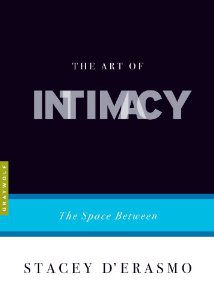
This slim, precise book, part of The Art of series from Graywolf Press, a collection of short books on writing edited by Charles Baxter, is a profound meditation on the relationships between fictional characters, the possibility and meaning of intimacy in fiction, and most vitally, an exploration by a master writer of how authors create relationships between readers and their stories.
D’Ersamo, the author of four novels and a professor of writing at Columbia University, presents incisive readings of a wide variety of fictional texts, from Percival Everett’s The Water Cure to D.H. Lawrence’s The Rainbow. The list of texts and the varieties of intimacy between characters, and between reader and stories, are not meant to be exhaustive, as D’Ersamo points out. Indeed, one of the main points of her argument is that the varieties of intimacy between characters, and between reader and story, are infinite.
D’Erasmo begins with readings of Elizabeth Bowen’s The House in Paris and William Maxwell’s So Long, See You Tomorrow. In Maxwell’s book, the narrator imagines the story of a childhood acquaintance whose father has killed his wife, and then himself. Years after these horrific events, the narrator sees the other boy at school, and fails to say hello to him. To make up for this slight, D’Ersamo writes, “an intense act of imagining takes place” as the narrator reconstructs the other boy’s story, continually reminding the reader that what he narrates is speculative: “[T]he subjunctive is standing on an acute sense of moral failure” and the book is “a kind of reparation for a failure of empathy.” In this act, the narrator “becomes a writer … [n]ot because he’s such a good storyteller, but because he failed … because he can achieve a union and a reunion, an intimacy in art that may not be possible in real life.” D’Erasmo’s argument that a writer’s acknowledgement of the distances between characters, and between art and life, between reader and writer, is central to her observations in her book about how writers create intimate relationships between readers and their stories.
In the next chapter, “Meeting in the World,” D’Erasmo defends D.H. Lawrence’s depiction of sex as a transcendental experience, not because it predicts romantic ideas of intimacy as a feel-good experience, but because it provokes in his characters a deep sense of alienation from the world, from themselves, and from each other. Similarly to the narrator in Maxwell’s novel, Lawrence’s characters experience intimacy as unsettling, destabilizing to the self, and this sense of strangeness is reflected in the characters’ “inchoate emotion subtending [their] perceptions of the world.” Lawrence “finds the force of the intimacy in the delineation of a force between them literally, figuratively, and syntactically… a space that … neither of them controls and that the reader understands not only as the characters’ connection, but also on a visceral level….”
In contrast with these stories, as well as Virginia Woolf’s use of image (“Meeting in the Image”) as a site of “transformative intimacy,” in which intimacy is erotic, D’Erasmo turns next, in a chapter titled “Meeting in the Dark,” to Joseph Conrad’s The Secret Sharer and Nella Larsen’s Passing, novels which end in the literal or figurative death of the other. The narrator in Conrad’s book conceals this violence, and seduces the reader into complicity with it, by use of maze-like, obfuscating description and an insistence on his identification with the “secret sharer,” the castaway whom at the end of the novel he sends to an uncertain fate. Larsen’s protagonist is a deeply repressed African-American woman whose childhood friend, another African American woman passing as white, reappears and presents an existential threat to the protagonist’s view of herself, a conflict she can resolve only by “reestablish[ing] her identity by the death, or perhaps the murder, of the one who causes her such ambivalence and doubt.” The exact nature of the threat, and even the facts of the other woman’s death are concealed, however, by the protagonist’s ambivalence about her own motives, an ambivalence in which Larsen entangles the reader by remaining strictly within the protagonist’s point of view. At the most extreme opposite from the narrator in Maxwell’s novel, D’Erasmo suggests, is the narrator in the Dennis Cooper story, “My Mark,” in which a spurned lover vivisects his former beloved through scathing, relentless description: “[T]he murder is a murder in language only … the writer makes the threatening other disappear into words.”

D’Erasmo then pauses to consider whether intimacy between characters in fiction is passé. She acknowledges that it is overused by writers as a form of “stakes” in fiction, in a cynical manner: “Like corn syrup, it fills stuff out and makes it tasty.” But she maintains that this failure does not reflect a failure in the possibility of intimacy as a subject for fiction per se, but a failure of writers to be open to a greater variety and possibility of intimacy in their work: “Intimacy is not a good place to go for ideals … [b]ut it is a tremendously fertile zone for all the emotions and mental state for which we have a name, and many for which we have no name at all.”
This stop-off in her argument sets the stage for the book’s final chapters, “Meeting in the White Space” and “Distance,” in which D’Erasmo considers the most extreme examples of intimacy between characters in her book, and what I also believe is the kernel of her argument about how authors create intimacy with their readers.
In each instance she has so far considered – whether in the rhetorical space of the subjunctive, the space of the image, of the characters’ perceptions of the world, of their own unreliability – D’Ersamo argues, stories create a topos, an artificial place where the author and reader meet. Our engagement in the fictional world occurs, she says, in this space. The final texts she considers replace these reassuring fictional spaces with white space, gaps in the narrative topos that engage the reader directly, or the extreme distance of the supernatural world Toni Morrison creates in Beloved, even as they seem to keep the reader at a distance. In her first example, Italo Calvino’s metafiction If on a winter’s night a traveler, the author engages the reader playfully. Joan Didion’s Play It As It Lays, however, through its fragmentation and numbness of its narrator, makes the reader complicit in the character’s nihilism. In Percival Everett’s The Water Cure, a novel written in a fragmentary style about a writer’s torture of another man, we become party, through the gaps in the narrative, to his crime.
In her reading of Beloved, D’Erasmo addresses the question which haunts The Art of Intimacy, and I would suggest, much of D’Erasmo’s own work, as well: “Why must this topos be created in order for the reader to apprehend intimacy? Why can’t we simply experience it directly, as we do in life?” It is a question that haunts innumerable creative writing courses, too, in students’ attempts to defend their stories because “this happened in real life.” D’Erasmo’s book is an answer to this question, and, although it contains no writing exercises and almost no direct advice to young writers, is an invaluable text for the writing classroom.
I will not spoil D’Erasmo’s masterful unraveling of how Morrison uses a ghost story to lay bare unspeakable truths, or her analysis of why the distance of a supernatural tale is necessary to convey the novel’s moral and emotional core. You will have to buy this indispensable book and find out.




